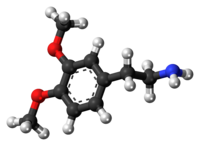3,4-ジメトキシフェネチルアミン
表示
| 3,4-ジメトキシフェネチルアミン | |
|---|---|

| |

| |
2-(3,4-dimethoxyphenyl)ethylamine | |
| 識別情報 | |
| CAS登録番号 | 120-20-7 |
| PubChem | 8421 |
| ChemSpider | 8114 |
| ChEBI | |
| ChEMBL | CHEMBL26019 |
| |
| |
| 特性 | |
| 化学式 | C10H15NO2 |
| モル質量 | 181.23 g/mol |
| 特記なき場合、データは常温 (25 °C)・常圧 (100 kPa) におけるものである。 | |
3,4-ジメトキシフェネチルアミン(3,4-Dimethoxyphenethylamine, DMPEA)は、フェネチルアミン系の化合物の1つである。ヒトの主要な神経伝達物質であるドーパミンの3位と4位のヒドロキシル基がメトキシ基に置き換わったアナログである。メスカリン(3,4,5-トリメトキシフェネチルアミン)とも密接な関連がある。
化学
[編集]当時は「ホモベラトリルアミン」と呼ばれていたDMPEAの初期の合成の1つは、PictetとFinkelsteinによるもので、彼らはバニリンを出発物質とする多段階過程で合成した[1]。その後、以下のような似た過程がBuckとPerkinによっても行われている[2]。
- ベラトルアルデヒド → 3,4-ジメトキシケイ皮酸 → 3,4-ジメトキシフェニルプロピオン酸 → 3,4-ジメトキシフェニルプロピオンアミド → 3,4-ジメトキシフェネチルアミン
より短い合成過程もShulginとShulginにより得られている[3][4]。
誘導体
[編集]ベバントロール合成に利用される。
薬理学
[編集]モノアミン酸化酵素阻害薬としての活性を持つ[5]。
天然の存在
[編集]多聞柱(Echinopsis pachanoi)やブラジル柱(Echinopsis peruviana)等のサボテンにメスカリンとともに含まれる[6][7][8]。
出典
[編集]- ^ A. Pictet and M. Finkelstein (1909). "Synthese des Laudanosins." Ber. 42 1979-1989.
- ^ J. S. Buck and W. H. Perkin (1924). "CCXVIII. Ψ-epiBerberine." J. Chem. Soc., Trans. 125 1675-1686.
- ^ A. Shulgin and A. Shulgin (1991). "PiHKAL A Chemical Love Story", pp. 614-616, Transform Press, Berkeley. ISBN 0-9630096-0-5
- ^ “Erowid Online Books : "PIHKAL" - #60 DMPEA”. 2020年1月10日閲覧。
- ^ Keller WJ; Ferguson GG (July 1977). “Effects of 3,4-dimethoxyphenethylamine derivatives on monoamine oxidase”. Journal of Pharmaceutical Sciences 66 (7): 1048-50. doi:10.1002/jps.2600660741. PMID 886445.
- ^ Lundstrom J (December 1970). “Biosynthesis of mescaline and 3,4-dimethoxyphenethylamine in Trichocereus pachanoi Br&R”. Acta Pharmaceutica Suecica 7 (6): 651-66. PMID 5511715.
- ^ Pummangura S; Nichols DE; McLaughlin JL (October 1977). “Cactus alkaloids XXXIII: beta-phenethylamines from the Guatemalan cactus Pilosocereus maxonii”. Journal of Pharmaceutical Sciences 66 (10): 1485-7. doi:10.1002/jps.2600661037. PMID 925910.
- ^ Pardanani JH; McLaughlin JL; Kondrat RW; Cooks RG (1977). “Cactus alkaloids. XXXVI. Mescaline and related compounds from Trichocereus peruvianus”. Lloydia 40 (6): 585-90. PMID 600028.
